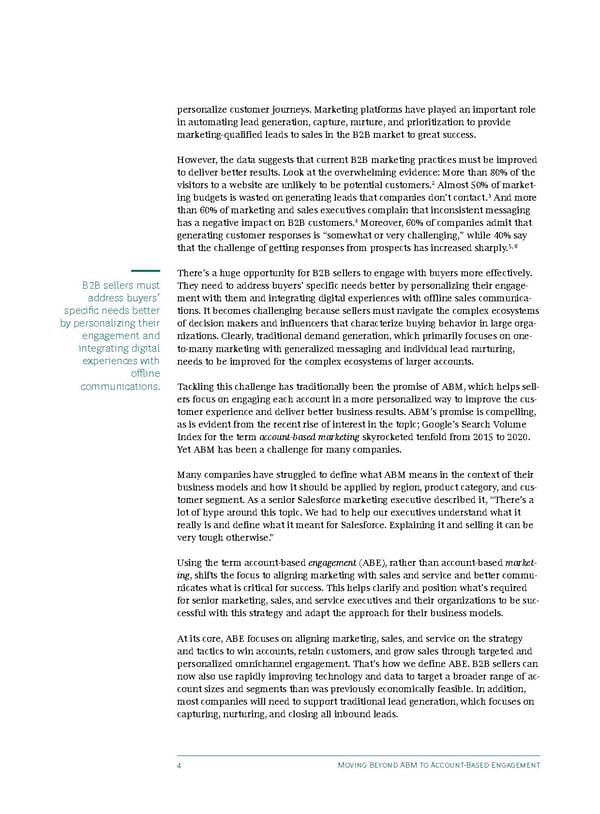personalize customer journeys. Marketing platforms have played an important role in automating lead generation, capture, nurture, and prioritization to provide marketing-qualified leads to sales in the B2B market to great success. However, the data suggests that current B2B marketing practices must be improved to deliver better results. Look at the overwhelming evidence: More than 80% of the 2 Almost 50% of market- visitors to a website are unlikely to be potential customers. 3 ing budgets is wasted on generating leads that companies don’t contact. And more than 60% of marketing and sales executives complain that inconsistent messaging has a negative impact on B2B customers.4 Moreover, 60% of companies admit that generating customer responses is “somewhat or very challenging,” while 40% say 5, 6 that the challenge of getting responses from prospects has increased sharply. There’s a huge opportunity for B2B sellers to engage with buyers more effectively. B2B sellers must They need to address buyers’ specific needs better by personalizing their engage- address buyers’ ment with them and integrating digital experiences with offline sales communica- specific needs better tions. It becomes challenging because sellers must navigate the complex ecosystems by personalizing their of decision makers and influencers that characterize buying behavior in large orga- engagement and nizations. Clearly, traditional demand generation, which primarily focuses on one- integrating digital to-many marketing with generalized messaging and individual lead nurturing, experiences with needs to be improved for the complex ecosystems of larger accounts. offline communications. Tackling this challenge has traditionally been the promise of ABM, which helps sell- ers focus on engaging each account in a more personalized way to improve the cus- tomer experience and deliver better business results. ABM’s promise is compelling, as is evident from the recent rise of interest in the topic; Google’s Search Volume Index for the term account-based marketing skyrocketed tenfold from 2015 to 2020. Yet ABM has been a challenge for many companies. Many companies have struggled to define what ABM means in the context of their business models and how it should be applied by region, product category, and cus- tomer segment. As a senior Salesforce marketing executive described it, “There’s a lot of hype around this topic. We had to help our executives understand what it really is and define what it meant for Salesforce. Explaining it and selling it can be very tough otherwise.” Using the term account-based engagement (ABE), rather than account-based market- ing, shifts the focus to aligning marketing with sales and service and better commu- nicates what is critical for success. This helps clarify and position what’s required for senior marketing, sales, and service executives and their organizations to be suc- cessful with this strategy and adapt the approach for their business models. At its core, ABE focuses on aligning marketing, sales, and service on the strategy and tactics to win accounts, retain customers, and grow sales through targeted and personalized omnichannel engagement. That’s how we define ABE. B2B sellers can now also use rapidly improving technology and data to target a broader range of ac- count sizes and segments than was previously economically feasible. In addition, most companies will need to support traditional lead generation, which focuses on capturing, nurturing, and closing all inbound leads. 4 Moving Beyond ABM to Account-Based Engagement
 BCG moving beyond ABM to account based engagement Page 5 Page 7
BCG moving beyond ABM to account based engagement Page 5 Page 7